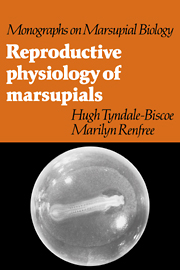Book contents
- Frontmatter
- Contents
- Preface
- 1 Historical introduction
- 2 Breeding biology of marsupials by family
- 3 Sexual differentiation and development
- 4 Male anatomy and spermatogenesis
- 5 The female urogenital tract and oogenesis
- 6 Ovarian function and control
- 7 Pregnancy and parturition
- 8 Lactation
- 9 Neuroendocrine control of seasonal breeding
- 10 Marsupials and the evolution of mammalian reproduction
- References
- Index
5 - The female urogenital tract and oogenesis
Published online by Cambridge University Press: 06 January 2010
- Frontmatter
- Contents
- Preface
- 1 Historical introduction
- 2 Breeding biology of marsupials by family
- 3 Sexual differentiation and development
- 4 Male anatomy and spermatogenesis
- 5 The female urogenital tract and oogenesis
- 6 Ovarian function and control
- 7 Pregnancy and parturition
- 8 Lactation
- 9 Neuroendocrine control of seasonal breeding
- 10 Marsupials and the evolution of mammalian reproduction
- References
- Index
Summary
The unusual nature of the anatomy of the female marsupial was first recognised by Tyson (1698), when he described the paired vascular ‘cornuauteri’ of Didelphis virginiana, each leading into a vaginal cul de sac and then to separate lateral vaginae. The paired uteri are invariably separate and open by separate cervices (Fig. 5.1) unlike in many species of Eutheria, which have a single chambered uterus and a single cervix. The lateral vaginae open posteriorly into a urogenital sinus, which also receives the urethra.
Anatomy of the urogenital tract
The oviduct
Study of the oviduct in marsupials has been neglected, possibly because the eggs pass through it so rapidly. Nevertheless, as in other mammals, it is a complex structure with a transport and secretory function. The oviducts vary considerably between species in length and in the degree of convolution but the transport of sperm and eggs must involve muscular contractions. The musculature consists of inner circular and outer longitudinal layers which allow peristaltic movement (Hartman, 1924).
The mucosal lining of the mammalian oviduct consists of an intricately folded, simple ciliated columnar epithelium which is interspersed with mucus-secreting cells (Nalbandov, 1969). A similar arrangement of cells occurs in the few marsupials examined (Hughes, 1974; Arnold & Shorey, 1985; Armati-Gulson & Lowe, 1985; Figs 4.22 and 5.2). Four regions of the mammalian oviduct can be distinguished according to the structure of the epithelium (Nilsson & Reinius, 1969), and the suggested classification of these authors is largely followed here.
The pre-ampulla includes both the fimbria and the infundibulum which pass into the ampulla, where fertilisation occurs in most mammals.
- Type
- Chapter
- Information
- Reproductive Physiology of Marsupials , pp. 172 - 202Publisher: Cambridge University PressPrint publication year: 1987
- 2
- Cited by



